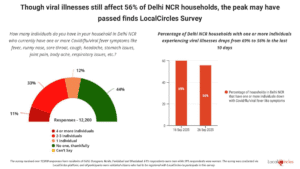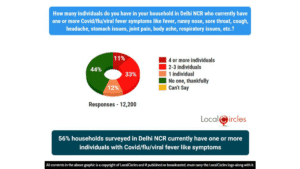Viral infections in Delhi NCR are finally showing a downward trend.
A LocalCircles survey of over 12,000 residents reveals that 56% of households now have one or more members with flu-like symptoms, compared to 69% just ten days earlier.
Doctors say the end of the monsoon on September 24 is the key reason for the drop.
Still, experts warn that the H3N2 influenza virus continues to circulate and people must remain cautious.
Survey Snapshot

The LocalCircles survey covered Delhi, Noida, Gurugram, Ghaziabad and Faridabad.
Its detailed findings show:
- 11% of families have four or more sick members.
- 33% report two to three people ill.
- 12% have only one person unwell.
- 44% say no one in their home is sick.
These numbers confirm that the peak of viral cases in Delhi NCR has passed.
But a significant portion of the population is still dealing with viral flu symptoms such as fever, sore throat, cough and fatigue.
Hospitals Remain Busy
Despite the decline, hospitals across the region continue to treat a steady stream of patients.
Doctors report many cases of h3n2 influenza, a strain known to cause prolonged weakness even after fever subsides.
Children, the elderly and those with chronic conditions remain at the highest risk.
“Admissions have slowed but are still higher than usual for this time of year,” said Dr. Rakesh Mehta, senior physician at a Delhi hospital.
Role of the Integrated Disease Surveillance Programme
The government tracks viral infections through the Integrated Disease Surveillance Programme (IDSP).
This network collects and tests samples every week, providing data at the state and national levels.
City-specific updates, however, take longer to compile.
That delay makes real-time surveys like this one a valuable source of breaking news for Delhi health officials.
Why the Numbers Fell
Experts say the end of the monsoon sharply reduces humidity.
Lower humidity slows the spread of the h3n2 flu virus, which thrives in damp air and crowded conditions.
Workplace attendance and packed public transport had contributed to the earlier surge.
Now, with clearer weather, transmission has started to drop across Delhi NCR.
Precaution Still Essential
Health specialists stress that fewer cases do not mean zero risk.
“The decline is welcome, but the virus is still here,” warned Dr. Anita Verma, community health consultant.
She recommends simple steps:
- Wear a mask in crowded places.
- Stay hydrated and rest if symptoms appear.
- Avoid self-medication and consult a doctor early.
- Keep children and elderly family members away from large gatherings.
Community Response
Many residents say they are following the advice.
Markets and offices report better attendance as fewer people fall sick.
Ramesh Sharma, a shopkeeper in Noida, said, “Two weeks ago almost everyone in my family had fever. Now only my wife has mild symptoms.”
Stories like his reflect the overall improvement captured in the survey.
What the Data Means
The LocalCircles poll, with 61% male and 39% female respondents, offers one of the most current pictures of public health in the region.
It shows that while viral cases are falling, more than half of households still have at least one sick member.
For hospitals and clinics, that means continued pressure to manage patient loads.
For residents, it means maintaining vigilance through the coming weeks.
Outlook for October
Weather experts expect cooler, drier air in the first half of October.
This should further slow the h3n2 influenza spread.
Doctors, however, warn of sudden temperature swings that can trigger new spikes in viral flu.
“The worst appears to be behind us, but Delhi NCR must remain careful until the season changes completely,” said Dr. Mehta.
The latest data shows a clear decline in Delhi NCR viral infections—from 69% of households to 56% in just ten days.
But with the h3n2 flu virus still active and many residents recovering, experts urge continued preventive measures.
Regular monitoring by the Integrated Disease Surveillance Programme and quick public updates will remain crucial.
For now, the region can breathe a little easier, while keeping masks and caution close at hand.
Quirk Report delivers today’s top stories, latest news, and breaking updates on India, world affairs, business, sports, and entertainment.








